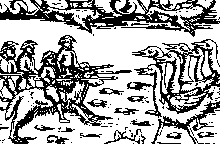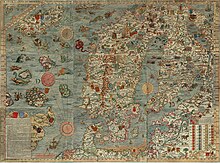Olaus Magnus: Difference between revisions
Task 18 (cosmetic): eval 3 templates: hyphenate params (1×); cvt lang vals (1×); |
m Reformatted an existing citation to be consistent with others |
||
| Line 94: | Line 94: | ||
The Italian title translates to "A little book, that more closely explains a map of the Nordic cold, beyond the Germanic sea located country, which presents its extremely peculiar, priorly known neither to Greeks or Latins, wonders of nature." It included a map of Northern Europe with a map of [[Scandinavia]], which was rediscovered by Oscar Brenner in 1886 in the [[Munich|München]] state library and shown to be the most accurate depiction of its time. The map is referred to as "carta marina", and consists of 9 parts, and is remarkably large: 125 cm tall and 170 cm wide. |
The Italian title translates to "A little book, that more closely explains a map of the Nordic cold, beyond the Germanic sea located country, which presents its extremely peculiar, priorly known neither to Greeks or Latins, wonders of nature." It included a map of Northern Europe with a map of [[Scandinavia]], which was rediscovered by Oscar Brenner in 1886 in the [[Munich|München]] state library and shown to be the most accurate depiction of its time. The map is referred to as "carta marina", and consists of 9 parts, and is remarkably large: 125 cm tall and 170 cm wide. |
||
Around 1550, Olaus also published rough sketches of snowflakes which later inspired further work on the subject by [[Wilson Bentley]] between 1884 and 1931 and [[Ukichiro Nakaya]] in the 1930s.<ref |
Around 1550, Olaus also published rough sketches of snowflakes which later inspired further work on the subject by [[Wilson Bentley]] between 1884 and 1931 and [[Ukichiro Nakaya]] in the 1930s.<ref>{{cite book|last=Wolfram|first=Stephen|authorlink=Stephen Wolfram|title=A New Kind of Science|url=https://www.wolframscience.com/nks/notes-8-2--history-of-snowflake-studies/|publisher=Wolfram Media, Inc.|year=2002|page=992|isbn=1-57955-008-8}}</ref> |
||
Following the death of his brother, he also let historical works that the brother had written be published. |
Following the death of his brother, he also let historical works that the brother had written be published. |
||
Revision as of 16:51, 5 January 2021
The Most Reverend Olaus Magnus | |
|---|---|
Roman Catholic | |
| Archdiocese | Uppsala |
| Appointed | 4 June 1544 |
| Term ended | 1 August 1557 |
| Predecessor | Johannes Magnus |
| Successor | Laurentius Petri |
| Personal details | |
| Born | October 1490 |
| Died | 1 August 1557 (aged 66) Rome, Papal States |
| Nationality | Swede |
Olaus Magnus (October 1490 – 1 August 1557) was a Swedish writer,
Biography

Olaus Magnus was born in
Settling in
Name
His original Swedish name was Olof Månsson (his last name meaning "son of Måns"; Magnus is a Latinized version of his patronymic second name, and not the literal personal epithet meaning "great").[1][2]
Works
He is best remembered as the author of the famous which long remained for the rest of Europe the authority on Swedish matters. This text on dark winters, violent currents and beasts of the sea amazed the rest of Europe. It was translated into Italian (1565), German (1567), English (1658) and Dutch (1665), and not until 1909 into Swedish. Abridgments of the work appeared also at Antwerp (1558 and 1562), Paris (1561), Amsterdam (1586), Frankfort (1618) and Leiden (1652). It is still today a valuable repertory of much curious information in regard to Scandinavian customs and folklore. A translation of the Latin title page goes: "Olaus Magnus Gothus', the Upsala Archbishops', history of the Nordic people's different manners and camps, also about the wonderful differences in customs, holy practices, superstitions, bodily exercises, government and food keeping; further on war, buildings and wonderful aids; further on metals and different kinds of animals, that live in these neighbourhoods (...)".

Olaus had already earlier written Carta marina et Descriptio septemtrionalium terrarum ac mirabilium rerum in eis contentarum, diligentissime elaborata Anno Domini 1539 Veneciis liberalitate Reverendissimi Domini Ieronimi Quirini, which translates as "A Marine map and Description of the Northern Lands and of their Marvels, most carefully drawn up at Venice in the year 1539 through the generous assistance of the Most Honourable Lord and Patriarch Hieronymo Quirino".[3] The Italian title translates to "A little book, that more closely explains a map of the Nordic cold, beyond the Germanic sea located country, which presents its extremely peculiar, priorly known neither to Greeks or Latins, wonders of nature." It included a map of Northern Europe with a map of Scandinavia, which was rediscovered by Oscar Brenner in 1886 in the München state library and shown to be the most accurate depiction of its time. The map is referred to as "carta marina", and consists of 9 parts, and is remarkably large: 125 cm tall and 170 cm wide.
Around 1550, Olaus also published rough sketches of snowflakes which later inspired further work on the subject by Wilson Bentley between 1884 and 1931 and Ukichiro Nakaya in the 1930s.[4]
Following the death of his brother, he also let historical works that the brother had written be published.
Present day oceanographers rediscovered Olaus Magnus' eye for detail (disregarding the sea monsters) and a series of scientific publications followed on Olaus' truthful depiction of currents between Iceland and the Faroe Islands.[citation needed]
External links
References
- ^ a b Description of the Northern Peoples. 1996. pp. xxvi–xxxvi.
- ^ Nordisk familjebok (in Swedish). Vol. 12. 1888. pp. 168–169. Retrieved 2011-12-24. article Olaus Magni
- ^ Lynam, Edward (1949). The Carta marina of Olaus Magnus. Tall Tree Library. p. 3.
- ISBN 1-57955-008-8.
- This article incorporates text from a publication now in the public domain: Chisholm, Hugh, ed. (1911). "Olaus Magnus". Encyclopædia Britannica (11th ed.). Cambridge University Press.
- Carta Marina James Bell Ford Library, Minnesota
- Carta Marina satellite images The Plymouth Marine Laboratory Remote Sensing Group webpage on correlations with current oceanography.
- Otto Hartig (1913). . In Herbermann, Charles (ed.). Catholic Encyclopedia. New York: Robert Appleton Company.

